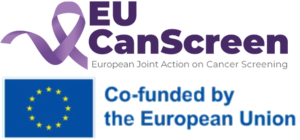Work Package 6:
Addressing barriers and facilitators in cancer screening
WP 6
Addressing

OUS, Norway
Work Package Summary
The overall objective is to coordinate and support activities reducing inequalities in access to and quality of breast, cervical and colorectal cancer screening programs and care services in Europe.
Specific objectives are as follows:
1) To identify and address barriers and facilitators both at the system level within various health systems and at the individual level within different cultures;
2) To facilitate the exchange of experiences and best practices among the MS to ensure sustainable breast, cervical and colorectal cancer screening programs.
OUS, Norway
Tasks
| Task Nr | Task Name | Description | Participants |
| T6.1 | Barrier and facilitator assessment and management in cancer screening programmes across Europe with the emphasis on barriers for successful screening implementation in Eastern and Central Europe | Eastern/Central European countries are characterised by delayed or only partial implementation of programs and a lower screening coverage compared to the Western European countries. Thus, a better understanding of barriers and facilitators is required by policy makers and at an organisational level in Eastern/Central European countries. The European barrier assessment tool developed in Task 4.3 will be used to identify the barriers to implementation of organized screening programmes in Eastern/Central European countries. The most useful evidence-based solutions will be used to address the barriers. This task will be led by LoR, Italy. | LU PMSI IO, CIPH,UZIS, PHCI,OIL LoR, AUSLRE, IOCN, NOI, DYPEDE, OUS, NNGYK, DOHI, CPO |
| T6.2 | Systemic barriers | Nations with established cancer screening programs regularly document key performance indicators, barriers, and facilitators typically within their native language ‘grey literature.’ Summarizing this dispersed knowledge across European MS requires significant commitment of time and resources. Task activities will be organized with the following subtasks: 6.2.1. Develop and provide health-policy decision-makers with an agile tool to improve organisation of breast, cervical and colorectal cancer screening. 6.2.2. Leverage an emerging disruptive technology such as large language models for efficient extraction of information on cancer screening barriers and facilitators across EU countries 6.3.3. Systematize and better understand systemic barriers to CRC screening in Europe given high CRC incidence, age-related nature, complexity, lower participation rates and economic impact. This task will be led by TAI, Estonia. | TAI, GÖG, PHCI, ISPRO, NIPH, OIL, ICO, DYPEDE, AUSLRE, CPO, LSMUKK, OUS, |
| T6.3 | Individual barriers | Achieving health equity in Europe requires clear understanding of individual barriers, and identification of strategies which increase cancer screening awareness, access, and uptake among the screening target group. This task will entail activities organised within the following subtasks: 6.3.1: A systematic review of individual barriers and facilitators that improve participation rates in cancer screening. The systematic search will consider tools and strategies from relevant fields of study (communication, technological sciences, medicine, etc.). 6.3.2: A case study to demonstrate how a data-driven approach can identify individual screening barriers and facilitators for non-participation in different screening programs and subpopulations. 6.3.3: Results of subtasks 6.3.2 and 6.3.1 will be combined to provide recommendations on how a data-driven approach can help prioritise approaches to addressing barriers and facilitators in cancer screening programs for in general public and sub-populations. This task will be led by RSYD, Denmark. | RSYD, GÖG, TAI, THL, DoH IE, OIL, PHC, ICO,PHCI CSF, DYPEDE, HSE, ISS, CPO, AUSLRE, LSMUKK, OUS, IACS, NCI, IU NAMSU |
| T6.4 | Immigrant populations | Strategies for increased cancer screening participation among immigrants will be developed, including increasing health literacy and awareness of cancer and cancer screening, through culturally-tailored communication. The task will entail activities organised within three subtasks: 6.4.1: Quantitative analyses of specific immigrant populations and the screening program coverage among screening target populations at country level, using EUROSTAT and national data sources, and a literature review of individual and system-level screening barriers among immigrants 6.4.2: Select 6-10 significant groups of immigrants and develop tailored screening information materials. The groups will be selected based on statistics (6.4.1), interest of partners contributing to this task, and insight of professionals with relevant knowledge on cultural context, healthcare systems and language. 6.4.3: Study the impact of using the newly developed materials and approaches compared to conventional invitation letters on screening attendance in a pilot, and develop guidelines for “best practice” for screening immigrants. This task will be led by OUS, Norway. | GÖG, RSYD,DoH IE, ISPRO, PHCI, RIVM OUS, CSF, MaR, CPO, IRFMN, RCC, AUSLRE, HSE |
| T6.5 | Improved cancer screening for people with intellectual disabilities (IDs) | 6.5.1. A literature review on cancer screening programs for people with IDs in Europe. The review will examine the effectiveness of existing cancer screening programs, access barriers and strategies that have been implemented to address these barriers, if any. 6.5.2. European stakeholders will be interviewed focusing on the experiences with cancer screening of people with IDs and strategies that have been effective in improving their cancer screening rates. 6.5.3. Analysis of available Norwegian Cancer Registry data on cancer screening in people with IDs. Norwegian registry data have several advantages over most other data from European countries and the analyses provided may serve as a template for collecting epidemiologic data in other countries as well. 6.5.4. A study on feasibility and acceptance of HPV self-sampling of selfsampling among long-term screening non-attenders with a mild to moderate mental disability will be conducted. It will consist of a literature review, a survey among health care professionals in (residential) nursing care, caretakers and women with a disability, and a feasibility study. Results will be synthesised to identify best practices for improving cancer screening for people with IDs in Europe and to guide future data collection and analysis. This task will be led by DKG, Germany. Major contributors will be Norway (6.5.3) and Belgium (6.5.4). | LU PHC, DoH IE, INCa, SCI, ICO, PHCI, ISPRO, DKG, CvKO, DYPEDE, HSE, AUSLRE, CPO, OUS, NCI, IU NAMSU |
| T6.6 | Outreach strategies to other vulnerable populations, including transgender populations | Individual and systemic barriers to cervical and breast cancer screening among gender minorities and other vulnerable populations will be examined within three subtasks: 6.6.1. A review of screening legislation and practices for cervical and breast cancer screening for gender minorities in each EU country. New EU-wide recommendations will be developed based on the information provided by this. 6.6.2. Development and piloting of an opt-in registry platform for inviting individuals who cannot be invited to the screening programs via population registries. 6.6.3. New inclusive screening materials with gender-neutral language (invitations, instructions, result letters) and educational materials for healthcare professionals will be created to minimize any discrimination and ensure safe healthcare visits for individuals in vulnerable positions. Campaigns to reach vulnerable populations and raise awareness of screening importance will be organised. This task will be led by CSF, Finland. | DoH IE, SoS, iSPRO, PHCI, SCI, ICO CSF, CvKO, DKG, NNGYK, HSE, AUSLRE, CPO, MaR, RSU, BVONL, OUS, RCC, |
| T6.7 | Strategies to increase health literacy in cancer screening | To assess the quality and shortcomings of existing patient info material on cancer screening and to generate a core template for evidence-based effective communication materials, activities will be executed within the following subtasks: 6.7.1 Collect and analyse existing patient info material on cancer screening from MS focusing on the degree of enabling informed decision making. The validated tool MAPPinfo https://www.stiftunggesundheitswissen. de/sites/default/files/2022-11/2022_11_MAPPinfo_Checkliste_engl-vf.pdf will be used. 6.7.2. Compile patient info template tool kit to enable informed decision making, that fulfils established evidence-based criteria on maximizing unbiasedness and comprehensibility of information. 6.7.3. Develop the concept of «Teach the Trainer» in the context of increasing health literacy and pilot the program performance. 6.7.4. Develop the screening-specific information, tool-kit (template of infographic and text blocks) and communication training material to increase literacy, test and revise for the target population. This task will be led by NNGYK, Hungary and by UWK, Austria, GÖG, Austria | GÖG, CIPH, PHCI, DoH IE, ISPRO, NIPH, OIL, RIVM NNGYK, UWK, UCY, HSE, AUSLRE, CPO, PROMIS, IRFMN, RSU, LSMUKK, OUS, IDIVAL, NCI |
| T6.8 | Information intervention and toolkit of best practice communication resources | The results from previous tasks and other projects on communications during the Covid pandemic (CovCom, led by a research group from the University of Stavanger) will be leveraged to develop a tool kit of best practice communication elements and concepts within the following sub-tasks: 6.8.1. Develop the best practices on communication and translation of complex but important health messages. Emphasis will be places on using videos for communication of health information, as well as text, pictures, and infographics via different dissemination channels. The value of these strategies will be validated in upcoming randomised controlled trials demonstrating their influence on participation, knowledge and awareness of the screening. 6.8.2. A reservoir with useful tools for screening programs across Europe will be compiled in order to provide different elements for building an effective information plan. This task will be led by OUS, Norway. | LU NIHD, THL, NKIP, ISPRO, OIL, ICO OUS, UMIT TIROL, RSYD, CSF, DKG, UWK, AUSLRE, RSU, LSMUKK, IOCN, RCC |
| Task Nr | Task Name | Description | Participants | Role | In-kind Contributions/Subcontracting |
| T6.1 | Barrier and facilitator assessment and management in cancer screening programmes across Europe with the emphasis on barriers for successful screening implementation in Eastern and Central Europe | Eastern/Central European countries are characterised by delayed or only partial implementation of programs and a lower screening coverage compared to the Western European countries. Thus, a better understanding of barriers and facilitators is required by policy makers and at an organisational level in Eastern/Central European countries. The European barrier assessment tool developed in Task 4.3 will be used to identify the barriers to implementation of organized screening programmes in Eastern/Central European countries. The most useful evidence-based solutions will be used to address the barriers. This task will be led by LoR, Italy. | LU PMSI IO, CIPH,UZIS, PHCI,OIL LoR, AUSLRE, IOCN, NOI, DYPEDE, OUS, NNGYK, DOHI, CPO | COO BEN AE | No |
| T6.2 | Systemic barriers | Nations with established cancer screening programs regularly document key performance indicators, barriers, and facilitators typically within their native language ‘grey literature.’ Summarizing this dispersed knowledge across European MS requires significant commitment of time and resources. Task activities will be organized with the following subtasks: 6.2.1. Develop and provide health-policy decision-makers with an agile tool to improve organisation of breast, cervical and colorectal cancer screening. 6.2.2. Leverage an emerging disruptive technology such as large language models for efficient extraction of information on cancer screening barriers and facilitators across EU countries 6.3.3. Systematize and better understand systemic barriers to CRC screening in Europe given high CRC incidence, age-related nature, complexity, lower participation rates and economic impact. This task will be led by TAI, Estonia. | TAI, GÖG, PHCI, ISPRO, NIPH, OIL, ICO, DYPEDE, AUSLRE, CPO, LSMUKK, OUS, | BEN AE | No |
| T6.3 | Individual barriers | Achieving health equity in Europe requires clear understanding of individual barriers, and identification of strategies which increase cancer screening awareness, access, and uptake among the screening target group. This task will entail activities organised within the following subtasks: 6.3.1: A systematic review of individual barriers and facilitators that improve participation rates in cancer screening. The systematic search will consider tools and strategies from relevant fields of study (communication, technological sciences, medicine, etc.). 6.3.2: A case study to demonstrate how a data-driven approach can identify individual screening barriers and facilitators for non-participation in different screening programs and subpopulations. 6.3.3: Results of subtasks 6.3.2 and 6.3.1 will be combined to provide recommendations on how a data-driven approach can help prioritise approaches to addressing barriers and facilitators in cancer screening programs for in general public and sub-populations. This task will be led by RSYD, Denmark. | RSYD, GÖG, TAI, THL, DoH IE, OIL, PHC, ICO,PHCI CSF, DYPEDE, HSE, ISS, CPO, AUSLRE, LSMUKK, OUS, IACS, NCI, IU NAMSU | BEN AE | No |
| T6.4 | immigrant populations | Strategies for increased cancer screening participation among immigrants will be developed, including increasing health literacy and awareness of cancer and cancer screening, through culturally-tailored communication. The task will entail activities organised within three subtasks: 6.4.1: Quantitative analyses of specific immigrant populations and the screening program coverage among screening target populations at country level, using EUROSTAT and national data sources, and a literature review of individual and system-level screening barriers among immigrants 6.4.2: Select 6-10 significant groups of immigrants and develop tailored screening information materials. The groups will be selected based on statistics (6.4.1), interest of partners contributing to this task, and insight of professionals with relevant knowledge on cultural context, healthcare systems and language. 6.4.3: Study the impact of using the newly developed materials and approaches compared to conventional invitation letters on screening attendance in a pilot, and develop guidelines for “best practice” for screening immigrants. This task will be led by OUS, Norway. | GÖG, RSYD,DoH IE, ISPRO, PHCI, RIVM OUS, CSF, MaR, CPO, IRFMN, RCC, AUSLRE, HSE | BEN AE | No |
| T6.5 | Improved cancer screening for people with intellectual disabilities (IDs) | 6.5.1. A literature review on cancer screening programs for people with IDs in Europe. The review will examine the effectiveness of existing cancer screening programs, access barriers and strategies that have been implemented to address these barriers, if any. 6.5.2. European stakeholders will be interviewed focusing on the experiences with cancer screening of people with IDs and strategies that have been effective in improving their cancer screening rates. 6.5.3. Analysis of available Norwegian Cancer Registry data on cancer screening in people with IDs. Norwegian registry data have several advantages over most other data from European countries and the analyses provided may serve as a template for collecting epidemiologic data in other countries as well. 6.5.4. A study on feasibility and acceptance of HPV self-sampling of selfsampling among long-term screening non-attenders with a mild to moderate mental disability will be conducted. It will consist of a literature review, a survey among health care professionals in (residential) nursing care, caretakers and women with a disability, and a feasibility study. Results will be synthesised to identify best practices for improving cancer screening for people with IDs in Europe and to guide future data collection and analysis. This task will be led by DKG, Germany. Major contributors will be Norway (6.5.3) and Belgium (6.5.4). | LU PHC, DoH IE, INCa, SCI, ICO, PHCI, ISPRO, DKG, CvKO, DYPEDE, HSE, AUSLRE, CPO, OUS, NCI, IU NAMSU | COO BEN AE | Yes (subcontracting) |
| T6.6 | Outreach strategies to other vulnerable populations, including transgender populations | Individual and systemic barriers to cervical and breast cancer screening among gender minorities and other vulnerable populations will be examined within three subtasks: 6.6.1. A review of screening legislation and practices for cervical and breast cancer screening for gender minorities in each EU country. New EU-wide recommendations will be developed based on the information provided by this. 6.6.2. Development and piloting of an opt-in registry platform for inviting individuals who cannot be invited to the screening programs via population registries. 6.6.3. New inclusive screening materials with gender-neutral language (invitations, instructions, result letters) and educational materials for healthcare professionals will be created to minimize any discrimination and ensure safe healthcare visits for individuals in vulnerable positions. Campaigns to reach vulnerable populations and raise awareness of screening importance will be organised. This task will be led by CSF, Finland. | DoH IE, SoS, iSPRO, PHCI, SCI, ICO CSF, CvKO, DKG, NNGYK, HSE, AUSLRE, CPO, MaR, RSU, BVONL, OUS, RCC, | BEN AE | No |
| T6.7 | Strategies to increase health literacy in cancer screening | To assess the quality and shortcomings of existing patient info material on cancer screening and to generate a core template for evidence-based effective communication materials, activities will be executed within the following subtasks: 6.7.1 Collect and analyse existing patient info material on cancer screening from MS focusing on the degree of enabling informed decision making. The validated tool MAPPinfo https://www.stiftunggesundheitswissen. de/sites/default/files/2022-11/2022_11_MAPPinfo_Checkliste_engl-vf.pdf will be used. 6.7.2. Compile patient info template tool kit to enable informed decision making, that fulfils established evidence-based criteria on maximizing unbiasedness and comprehensibility of information. 6.7.3. Develop the concept of «Teach the Trainer» in the context of increasing health literacy and pilot the program performance. 6.7.4. Develop the screening-specific information, tool-kit (template of infographic and text blocks) and communication training material to increase literacy, test and revise for the target population. This task will be led by NNGYK, Hungary and by UWK, Austria, GÖG, Austria | GÖG, CIPH, PHCI, DoH IE, ISPRO, NIPH, OIL, RIVM NNGYK, UWK, UCY, HSE, AUSLRE, CPO, PROMIS, IRFMN, RSU, LSMUKK, OUS, IDIVAL, NCI | BEN AE | No |
| T6.8 | Information intervention and toolkit of best practice communication resources | The results from previous tasks and other projects on communications during the Covid pandemic (CovCom, led by a research group from the University of Stavanger) will be leveraged to develop a tool kit of best practice communication elements and concepts within the following sub-tasks: 6.8.1. Develop the best practices on communication and translation of complex but important health messages. Emphasis will be places on using videos for communication of health information, as well as text, pictures, and infographics via different dissemination channels. The value of these strategies will be validated in upcoming randomised controlled trials demonstrating their influence on participation, knowledge and awareness of the screening. 6.8.2. A reservoir with useful tools for screening programs across Europe will be compiled in order to provide different elements for building an effective information plan. This task will be led by OUS, Norway. | LU NIHD, THL, NKIP, ISPRO, OIL, ICO OUS, UMIT TIROL, RSYD, CSF, DKG, UWK, AUSLRE, RSU, LSMUKK, IOCN, RCC | COO BEN AE | Yes (subcontracting) |
Subscribe to our newsletter to get news and updates.
Subscribe to our newsletter to get news and updates.

The general objective of EUCanScreen is to assure sustainable implementation of high-quality screening for breast, cervical and colorectal cancers, as well as implementation of the recently recommended screening programs – for lung, prostate and gastric cancers. EUCanScreen will facilitate the reduction of cancer burden and achieving equity across the EU.
This project has received funding from the European Union’s EU4HEALTH Programme under the Grant Agreement no 101162959











